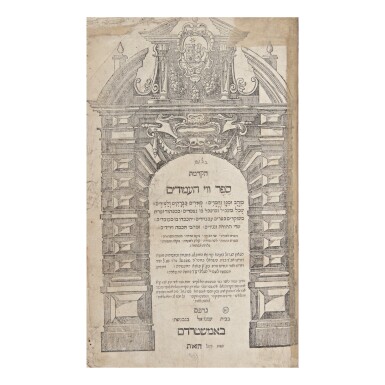Sacred Splendor: Judaica from the Arthur and Gitel Marx Collection
Sacred Splendor: Judaica from the Arthur and Gitel Marx Collection

SEFER SHENEI LUHOT HA-BERIT AND HAKDAMAT SEFER VAVEI HA-AMMUDIM (COMPENDIUM OF HALAKHAH, KABBALAH, AND ETHICS), RABBIS ISAIAH AND SHABBETAI SHEFTEL HA-LEVI HOROWITZ, AMSTERDAM: IMMANUEL BENVENISTE, 1648-1649
Auction Closed
November 20, 08:47 PM GMT
Estimate
10,000 - 15,000 USD
Lot Details
Description
SEFER SHENEI LUHOT HA-BERIT AND HAKDAMAT SEFER VAVEI HA-AMMUDIM (COMPENDIUM OF HALAKHAH, KABBALAH, AND ETHICS), RABBIS ISAIAH AND SHABBETAI SHEFTEL HA-LEVI HOROWITZ, AMSTERDAM: IMMANUEL BENVENISTE, 1648-1649
2 parts in 1 volume (12 1/8 x 7 7/8 in.; 308 x 200 mm): Part 1 (Sefer shenei luhot ha-berit): 424 folios; Part 2 (Hakdamat sefer vavei ha-ammudim): 44 folios on paper. Part 1: Decorative woodcut letters forming enlarged incipits on ff. [i], [1r], 38v, 110v, 264r; schematic representation of author’s name on f. [ii]; diagrams on ff. 102r, 105r, 118r; decorative elements on f. 417r; printer’s device on f. [422v]; episodic manuscript marginalia in pen. Slight scattered staining (obscuring a bit of text on f. 303v); staining in outer edges; some dogearing; occasional minor worming in margins not affecting text; small paper imperfections in upper-outer corners of ff. 74, 323 and in outer edges of ff. 263, 287; short tears in outer edges of ff. 93, 224, 285, in lower edges of ff. 140, 226-227, [232], [235], [237-238], 351, 371, 381, in gutter of f. 156, and in upper edges of ff. 248, 281-282; small holes in outer edges of ff. 398, [422]; tape repair in gutter at head of f. [422]. Part 2: Title within architectural frame surmounted by printer’s device; initial word on f. 3v within ornamental woodcut vignette; decorative elements on ff. 23v, 37v, 44v. Slight scattered staining; some dogearing; tape repairs on f. [1], with small losses in outer edges; ff. [1]-3 reinforced along gutter; scratches on ff. 2v-3r obscuring a few words; upper-outer corner of f. 19 lacking; paper imperfection in outer edge of f. 29. Half calf over board, scuffed and worn along edges; title, place, and date lettered in gilt on spine; spine rubbed; short tears at head and foot of spine; reddish edges; later paper flyleaves and pastedowns.
The first edition of this encyclopedic and oft-reprinted work.
Immanuel (or, as he wrote it, Imanoel) Benveniste (ca. 1608-1664), a descendant of Iberian conversos, came to Amsterdam from Venice and there began printing in about 1639. By the time he closed his business two decades later, he had issued at least forty-eight Hebrew and six non-Hebrew editions, whose excellent quality won him great renown in the Hebrew publishing world, superseding even that of the incomparable Menasseh Ben Israel. The present lot is a copy of one of the titles Benveniste produced.
Rabbi Isaiah ha-Levi Horowitz (ca. 1565-1630), a native of Prague who moved to Poland in his youth, studied there under some of the most eminent scholars of the day and quickly gained a reputation for his own exceptional learning. After serving Jewish communities in Dubno, Ostrog, Frankfurt am Main, and Prague, he moved to the Holy Land in 1621, becoming the head of the Ashkenazic community of Jerusalem. Before leaving the Diaspora, he began working on his magnum opus, Sefer shenei luhot ha-berit (The Two Tablets of the Law), completing it about two years after his relocation. Intended originally for his family and their descendants, the work was published posthumously by his son Rabbi Shabbetai Sheftel (ca. 1590-ca. 1660) once he read in his father’s introduction that it could be made available to Horowitz’s students. “Then I said in my heart: since it was permitted to some, it has been permitted to all of Israel, for his students have dispersed throughout almost the entire Diaspora.”
The book takes as its main organizing principle a verse from Proverbs (6:23): “For the commandment is a lamp, the teaching is a light, and the way to life is the rebuke that disciplines.” These three phrases are interpreted to refer to halakhah, Kabbalah, and ethics, respectively. Sefer shenei luhot ha-berit addresses each topic at length over the course of three ten-part chapters (with various appendices) entitled Ba-asarah ma’amarot, Aseret ha-dibberot, and Asarah hillulim. The volume closes with a(n unrelated) six-part ethical-homiletical treatise penned by the younger Horowitz entitled Hakdamat sefer vavei ha-ammudim, whose name was meant to echo the Sefer ammudei shesh (Prague, 1617) of Rabbi Solomon Ephraim of Luntshits (1550-1619).
Sefer shenei luhot ha-berit (also known by the acronym Shelah) achieved enormous popularity (see lot 85), especially in its epitomized form, Kitsur shelah, which has gone through numerous editions since it first appeared in Fürth in 1693. Horowitz himself came to be referred to as “The Holy Shelah” on account of the high esteem in which this sacred book was held. The work was particularly influential among early Hasidic masters like Rabbis Israel Ba‘al Shem Tov (ca. 1700-1760) and Shneur Zalman of Liadi (1745-1812) and continues to be studied and revered down to the present day.
Provenance
BJ (title pages of Sefer shenei luhot ha-berit and of Hakdamat sefer vavei ha-ammudim)
Literature
Lajb Fuks and Renate G. Fuks-Mansfeld, Hebrew Typography in the Northern Netherlands[,] 1585-1815: Historical Evaluation and Descriptive Bibliography, vol. 1 (Leiden: E.J. Brill, 1984), 146-153, 173 (no. 223).
Marvin J. Heller, “The Printer’s Mark of Immanuel Benveniste and Its Later Influence,” Studies in Bibliography and Booklore 19 (1994): 3-20.
Marvin J. Heller, The Seventeenth Century Hebrew Book: An Abridged Thesaurus, vol. 1 (Leiden; Boston: Brill, 2011), 654-655.
Chaim and Betzalel Stefansky, Sifrei yesod: sifrei ha-yesod shel ha-sifriyyah ha-yehudit ha-toranit (n.p.: Chaim and Betzalel Stefansky, 2019), 101 (no. 359).
Vinograd, Amsterdam 163
